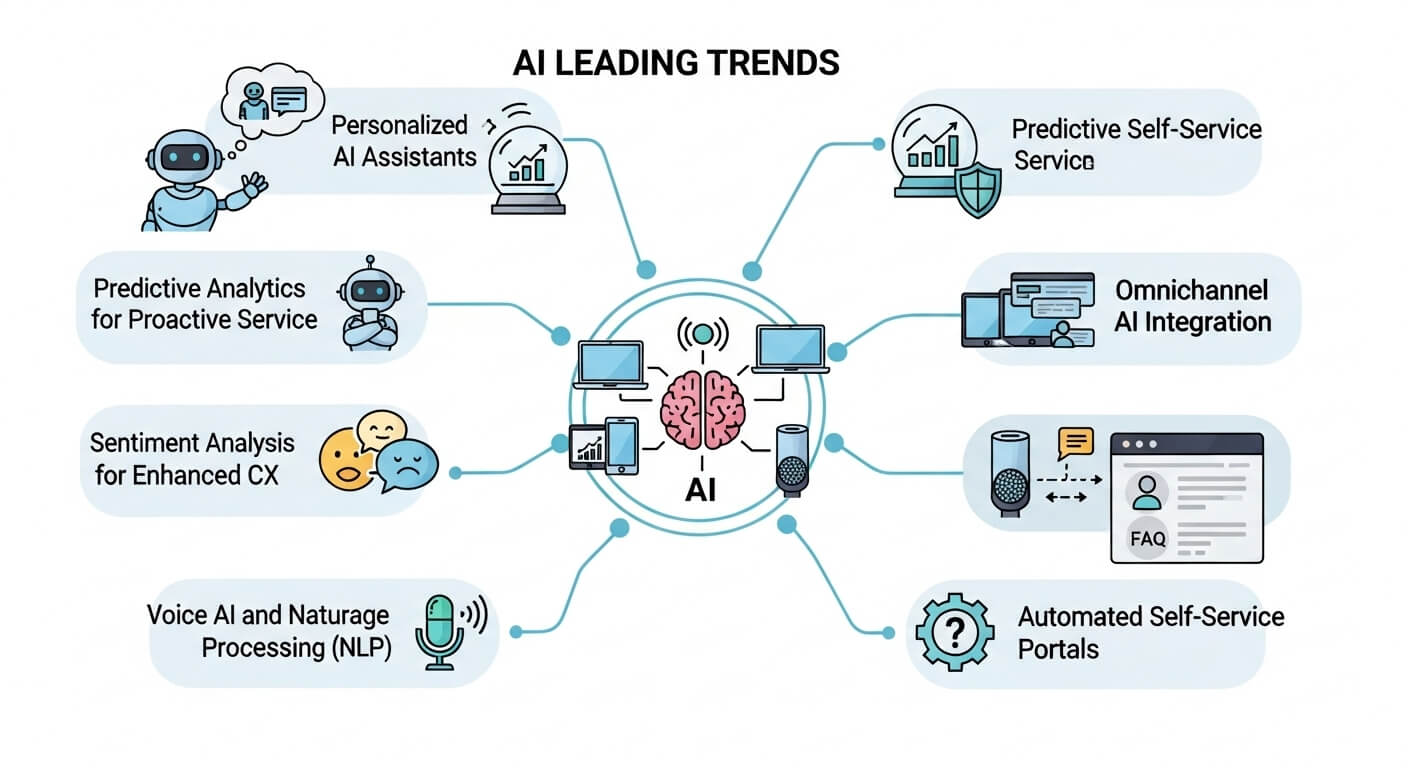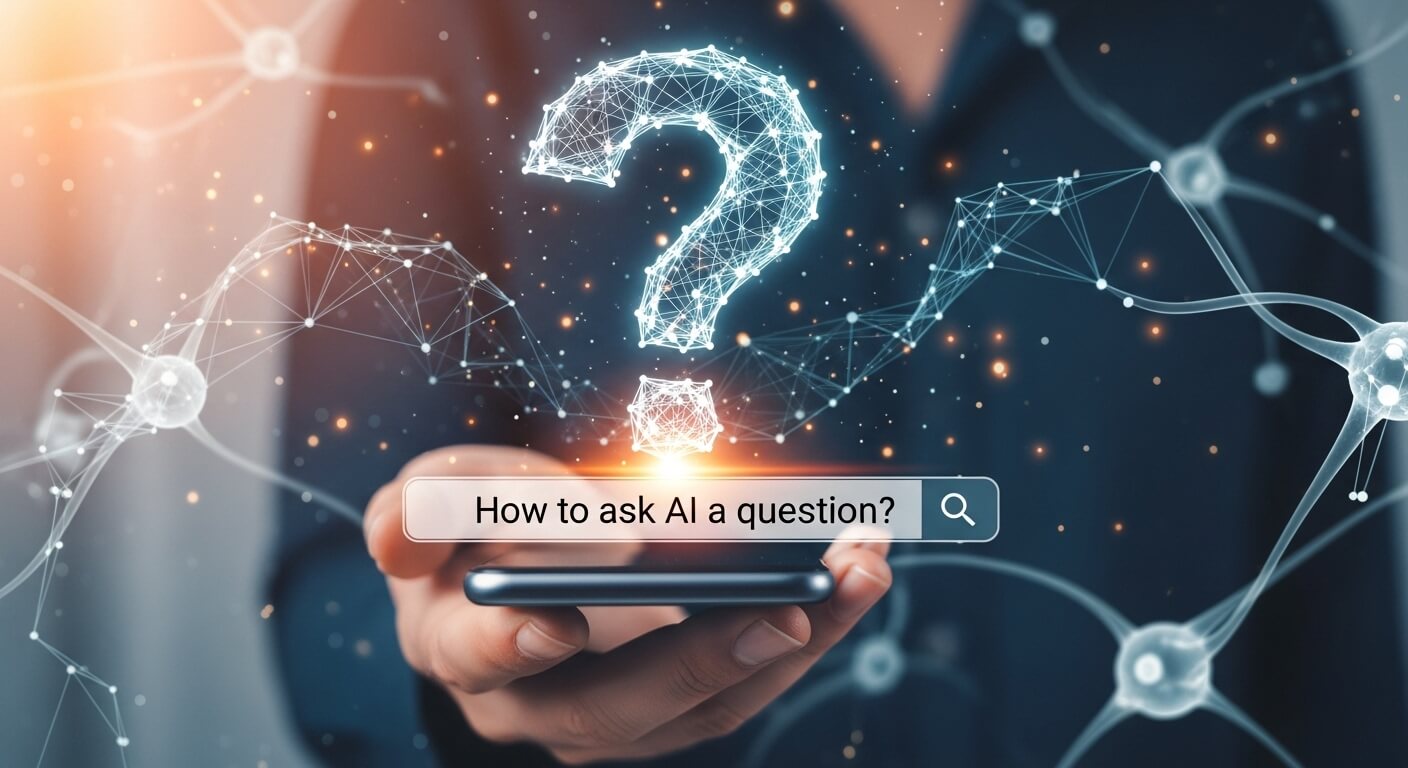AI-powered customer service is revolutionizing how businesses engage with their customers, delivering personalized, efficient, and scalable solutions. As companies strive to meet rising consumer expectations, what are the leading trends in AI-powered customer service is a critical question for professionals aiming to enhance customer experiences and drive loyalty. From conversational AI chatbots to hyper-personalization and predictive analytics, AI is transforming customer support across industries like retail, finance, and healthcare. This comprehensive 3,000-word guide explores the top trends shaping AI-powered customer service in 2025, supported by authoritative insights, real-world examples, and actionable strategies to help businesses stay competitive.
Why AI-Powered Customer Service Matters
Customer expectations for fast, personalized, and seamless support have never been higher. According to AmplifAI, 59% of companies see generative AI transforming customer interactions, with 70% of customer experience (CX) leaders planning to integrate it by 2026. AI-powered customer service offers:
- 24/7 Availability: AI chatbots and virtual assistants provide round-the-clock support.
- Cost Efficiency: Automation reduces operational costs by up to 30%, per McKinsey.
- Personalization: AI tailors interactions to individual preferences, boosting satisfaction.
- Scalability: Handles high volumes of inquiries without compromising quality.
- Data-Driven Insights: AI analyzes customer behavior to improve service strategies.
This guide highlights the leading trends, credible sources, and practical applications to help you navigate the future of AI-powered customer service.
Top Trends in AI-Powered Customer Service (2025)
Drawing from industry reports, expert analyses, and real-time data, the following trends are shaping the future of AI-powered customer service.
1. Conversational AI and Advanced Chatbots
Conversational AI, powered by Large Language Models (LLMs) like GPT-4, is enabling chatbots to handle complex, human-like interactions with unprecedented accuracy.
- What to Expect:
- Chatbots will resolve 70% of customer inquiries by 2026, per AmplifAI.
- Multilingual capabilities will expand global reach, supporting 95% of global languages.
- Natural language understanding (NLU) will improve intent recognition, reducing escalations.
- Integration with voice assistants like Alexa for seamless voice-based support.
- Forbes projects the conversational AI market to reach $377 billion by 2032.
- Industries Impacted: Retail, finance, healthcare, travel.
- Sources:
- AmplifAI: “60+ Generative AI Statistics You Need to Know in 2025” highlights chatbot adoption.
- Forbes: Discusses conversational AI market growth.
- Publicis Sapient: “Guide to Next 2025” emphasizes no-code chatbots like WeBoard’s Kaila.
- Example: WeBoard’s Kaila chatbot automates customer support with no-code integration, improving response times by 40%.
2. Hyper-Personalization Through AI
AI-driven hyper-personalization tailors customer interactions based on real-time data, preferences, and behavior, enhancing engagement and loyalty.
- What to Expect:
- AI will analyze browsing history, purchase patterns, and social media to create personalized responses.
- 67% of CMOs are exploring generative AI for personalization, per Publicis Sapient.
- Real-time personalization will drive 20% higher conversion rates, per McKinsey.
- Predictive models will anticipate customer needs, offering proactive solutions.
- Industries Impacted: Retail, e-commerce, finance, hospitality.
- Sources:
- Publicis Sapient: Discusses AI in content supply chains for personalization.
- McKinsey: Highlights personalization’s impact on conversions.
- StartUs Insights: Tracks 16,520 AI companies, emphasizing personalization trends.
- Example: Mondelēz International uses AI to personalize marketing campaigns, boosting engagement by 25%.
3. Predictive Analytics for Proactive Support
Predictive analytics leverages AI to anticipate customer issues, enabling proactive support and reducing churn.
- What to Expect:
- AI will predict customer inquiries based on historical data, reducing ticket volumes by 15%, per Gartner.
- Sentiment analysis will identify frustrated customers for immediate intervention.
- Integration with CRM systems like Salesforce for seamless data flow.
- Predictive models will optimize staffing and resource allocation.
- Industries Impacted: Customer service, telecom, finance, healthcare.
- Sources:
- Gartner: Hype Cycle for AI 2025 notes predictive analytics growth.
- AmplifAI: Reports 59% of companies transforming CX with predictive AI.
- Forbes: Discusses AI-driven churn reduction.
- Example: Salesforce’s Einstein AI predicts customer churn, enabling proactive outreach.
4. Voice AI and Omnichannel Integration
Voice AI, combined with omnichannel platforms, ensures seamless customer experiences across channels like phone, chat, email, and social media.
- What to Expect:
- Voice assistants will handle 30% of customer interactions by 2027, per Statista.
- Omnichannel AI will unify customer data for consistent support across platforms.
- Voice sentiment analysis will enhance emotional intelligence in responses.
- Integration with platforms like WhatsApp and X for real-time engagement.
- Industries Impacted: Retail, travel, healthcare, banking.
- Sources:
- Statista: Projects voice AI market growth.
- Publicis Sapient: Highlights omnichannel AI trends.
- Forbes: Discusses voice AI in customer service.
- Example: Amazon’s Alexa integrates with customer service systems for voice-based support.
5. AI-Driven Self-Service Solutions
Self-service options, powered by AI, empower customers to resolve issues independently, reducing support costs.
- What to Expect:
- AI knowledge bases and FAQs will handle 50% of inquiries, per AmplifAI.
- Interactive AI tools like virtual agents will guide users through troubleshooting.
- Generative AI will create dynamic, user-specific FAQ content.
- Self-service adoption will save businesses $11 billion annually by 2026, per McKinsey.
- Industries Impacted: Technology, retail, telecom, education.
- Sources:
- AmplifAI: Details self-service adoption rates.
- McKinsey: Highlights cost savings from self-service.
- StartUs Insights: Tracks AI-driven self-service startups.
- Example: Zendesk’s AI-powered Answer Bot resolves common inquiries instantly.
6. Ethical AI and Customer Trust
Ethical AI frameworks are critical for building trust, addressing concerns like bias, privacy, and transparency in customer interactions.
- What to Expect:
- Explainable AI (XAI) will clarify how AI makes decisions, boosting trust.
- Compliance with regulations like the EU AI Act (effective 2026) will be mandatory.
- 45% of organizations cite governance as a challenge, per McKinsey.
- Transparent AI policies will reduce customer skepticism.
- Industries Impacted: Finance, healthcare, retail, government.
- Sources:
- McKinsey: Discusses AI governance challenges.
- Forbes: Highlights ethical AI in customer service.
- Stanford AI Index: Tracks global AI regulation trends.
- Example: IBM’s Watson adheres to ethical AI guidelines for transparent customer interactions.
7. AI-Augmented Human Agents
AI is augmenting human agents, enhancing productivity rather than replacing them.
- What to Expect:
- AI will provide real-time suggestions to agents, improving response quality.
- 60% of managers expect entry-level roles to shift to reviewing AI outputs, per HBR.
- AI will reduce agent training time by 30%, per AmplifAI.
- Sentiment analysis will guide agents to handle emotional escalations.
- Industries Impacted: Customer service, telecom, finance, healthcare.
- Sources:
- HBR: Discusses workforce shifts in AI-augmented roles.
- AmplifAI: Highlights agent productivity gains.
- Gartner: Predicts AI augmentation in CX.
- Example: Salesforce’s Service Cloud uses AI to suggest responses to agents.
8. AI in Sentiment Analysis and Emotional Intelligence
AI is enhancing customer service by analyzing emotions and sentiments, enabling empathetic responses.
- What to Expect:
- Sentiment analysis will identify customer frustration in real-time.
- Emotional AI will tailor responses to customer mood, improving satisfaction by 15%, per Gartner.
- Integration with voice and text channels for holistic sentiment tracking.
- Market growth to $3.8 billion by 2030, per Statista.
- Industries Impacted: Retail, hospitality, healthcare, finance.
- Sources:
- Gartner: Highlights emotional AI trends.
- Statista: Projects sentiment analysis market growth.
- Forbes: Discusses emotional intelligence in AI.
- Example: Affectiva’s AI analyzes customer emotions for tailored support.
9. AI-Powered Analytics for CX Insights
AI analytics provide actionable insights into customer behavior, preferences, and pain points.
- What to Expect:
- AI will analyze call logs, chats, and reviews to identify trends.
- Predictive analytics will forecast customer needs, reducing churn by 10%, per McKinsey.
- Real-time dashboards will optimize CX strategies.
- Integration with CRMs for unified data insights.
- Industries Impacted: Retail, finance, telecom, e-commerce.
- Sources:
- McKinsey: Highlights analytics-driven CX improvements.
- AmplifAI: Details AI analytics adoption.
- Publicis Sapient: Discusses data-driven CX.
- Example: HubSpot’s AI analytics track customer journey metrics.
10. No-Code and Low-Code AI Platforms
No-code and low-code platforms are democratizing AI adoption, enabling businesses to deploy customer service solutions without extensive coding.
- What to Expect:
- Platforms like WeBoard and Bubble will simplify AI chatbot deployment.
- 70% of CX leaders will adopt no-code AI by 2026, per Publicis Sapient.
- Reduced implementation costs and faster deployment timelines.
- Scalable solutions for SMEs and enterprises.
- Industries Impacted: Retail, technology, education, healthcare.
- Sources:
- Publicis Sapient: Highlights no-code AI trends.
- StartUs Insights: Tracks no-code AI startups.
- Forbes: Discusses accessibility of AI platforms.
- Example: WeBoard’s Kaila enables no-code chatbot creation.
Where to Find Reliable Insights on AI-Powered Customer Service
To stay updated on these trends, leverage these authoritative sources:
- AmplifAI (www.amplifai.com):
- “60+ Generative AI Statistics You Need to Know in 2025” covers CX adoption.
- Example: 59% of companies see generative AI transforming customer interactions.
- McKinsey & Company (www.mckinsey.com):
- Annual AI surveys highlight CX cost savings and personalization.
- Example: AI reduces customer service costs by 30%.
- Publicis Sapient (www.publicissapient.com):
- “Guide to Next 2025” discusses no-code AI and personalization.
- Example: 28% of U.S. workers use generative AI daily.
- Forbes (www.forbes.com):
- Articles like “The Future of Generative AI in CX” provide expert insights.
- Covers conversational AI and emotional intelligence.
- Gartner (www.gartner.com):
- Hype Cycle for AI 2025 tracks conversational and predictive AI.
- Access via subscriptions or event summaries (e.g., Gartner IT Symposium, September 2025).
- X Platform:
- Search hashtags like #AICustomerService, #GenerativeAI, or #CX2025 for real-time discussions.
- Verify posts with primary sources like McKinsey or AmplifAI.
High-Volume Questions About AI-Powered Customer Service
To address user queries and align with search intent, here are answers to popular questions:
1. What Are the Leading Trends in AI-Powered Customer Service for 2025?
- Answer: Top trends include:
- Conversational AI and chatbots resolving 70% of inquiries.
- Hyper-personalization for tailored customer experiences.
- Predictive analytics for proactive support.
- Voice AI and omnichannel integration for seamless interactions.
- Sources: AmplifAI, Publicis Sapient, Forbes.
2. How Does AI Improve Customer Service Efficiency?
- Answer: AI automates repetitive tasks, reduces response times by 40%, and saves 30% in operational costs. Self-service solutions handle 50% of inquiries.
- Sources: McKinsey, AmplifAI, Gartner.
3. What Is the Role of Conversational AI in Customer Service?
- Answer: Conversational AI powers chatbots and virtual assistants, handling complex queries with NLU. The market is projected to reach $377 billion by 2032.
- Sources: Forbes, AmplifAI, Publicis Sapient.
4. How Does AI Enable Hyper-Personalization in Customer Service?
- Answer: AI analyzes customer data to tailor responses, increasing conversions by 20%. Examples include personalized product recommendations and targeted support.
- Sources: McKinsey, Publicis Sapient, StartUs Insights.
5. What Are the Ethical Challenges of AI in Customer Service?
- Answer: Challenges include bias in AI models, data privacy concerns, and transparency. Compliance with the EU AI Act (2026) will address these issues.
- Sources: McKinsey, Forbes, Stanford AI Index.
6. How Can Small Businesses Adopt AI-Powered Customer Service?
- Answer: Use no-code platforms like WeBoard, focus on cost-effective chatbots, and integrate with CRMs like HubSpot for scalable solutions.
- Sources: Publicis Sapient, StartUs Insights, Forbes.
7. How Do I Measure the Success of AI in Customer Service?
- Answer: Track metrics like:
- Response time reduction (40% with AI, per AmplifAI).
- Customer satisfaction scores (15% increase, per Gartner).
- Cost savings (30%, per McKinsey).
- Churn reduction (10%, per McKinsey).
- Sources: AmplifAI, Gartner, McKinsey.
Best Practices for Leveraging AI-Powered Customer Service Trends
To adopt these trends effectively:
- Prioritize Authoritative Sources:
- Use McKinsey, AmplifAI, and Gartner for data-driven insights.
- Verify X posts with primary reports to ensure accuracy.
- Focus on Industry-Specific Applications:
- Retail: Prioritize hyper-personalization (e.g., Mondelēz case study).
- Finance: Use predictive analytics for fraud detection.
- Healthcare: Leverage conversational AI for patient support.
- Engage with Real-Time Updates:
- Follow #AICustomerService on X.
- Subscribe to newsletters from Forbes and Publicis Sapient.
- Attend webinars like Gartner IT Symposium (September 2025).
- Address E-E-A-T:
- Experience: Reference case studies (e.g., WeBoard’s Kaila).
- Expertise: Cite authors like Ashish Sukhadeve (Forbes).
- Authoritativeness: Use data from McKinsey and Gartner.
- Trustworthiness: Include citations and reputable sources.
- Monitor Emerging Technologies:
- Track conversational AI, no-code platforms, and sentiment analysis.
- Stay updated on regulations like the EU AI Act.
- Invest in workforce training for AI-augmented roles.
Case Studies: AI-Powered Customer Service in Action
Case Study 1: Retail (Mondelēz International)
- Overview: Partnered with Publicis Groupe to use AI for personalized marketing and customer support, tailoring content to regional preferences.
- Impact: 25% increase in customer engagement.
- Source: Publicis Sapient.
Case Study 2: Customer Service (WeBoard)
- Overview: Deployed Kaila, a no-code AI chatbot, to automate support, reducing response times by 40%.
- Impact: Improved customer satisfaction and lowered costs.
- Source: Publicis Sapient.
Case Study 3: Finance (Salesforce)
- Overview: Used Einstein AI for predictive analytics, identifying at-risk customers and enabling proactive support.
- Impact: 10% reduction in churn.
- Source: Salesforce case studies.
Common Pitfalls to Avoid
- Ignoring Data Privacy: Ensure compliance with GDPR and EU AI Act.
- Over-Reliance on Automation: Balance AI with human agents for complex issues.
- Neglecting Analytics: Track metrics to optimize performance.
- Using Outdated Tools: Adopt modern platforms like WeBoard or Zendesk.
- Failing to Upskill: Train agents to work with AI, per HBR’s recommendations.
How to Stay Ahead in AI-Powered Customer Service
To remain competitive:
- Subscribe to Newsletters: McKinsey, Forbes, AmplifAI.
- Join Communities: X discussions (#AICustomerService), LinkedIn CX groups.
- Attend Events: Gartner IT Symposium, AI & Big Data Expo.
- Leverage Tools: AmplifAI, StartUs Insights, Salesforce.
- Upskill: Enroll in AI courses on Coursera or Salesforce.
Conclusion
The question “What are the leading trends in AI-powered customer service?” is answered by exploring transformative developments like conversational AI, hyper-personalization, predictive analytics, and ethical frameworks. By leveraging authoritative sources like McKinsey, AmplifAI, and Publicis Sapient, businesses can adopt these trends to enhance customer experiences, reduce costs, and drive loyalty. From no-code platforms to sentiment analysis, these innovations are reshaping customer support in 2025. Start implementing these strategies and monitoring reliable sources to stay at the forefront of AI-powered customer service and achieve lasting success.

The editor of All-AI.Tools is a professional technology writer specializing in artificial intelligence and chatbot tools. With a strong focus on delivering clear, accurate, and up-to-date content, they provide readers with in-depth guides, expert insights, and practical information on the latest AI innovations. Committed to fostering understanding of fun AI tools and their real-world applications, the editor ensures that All-AI.Tools remains a reliable and authoritative resource for professionals, developers, and AI enthusiasts.



